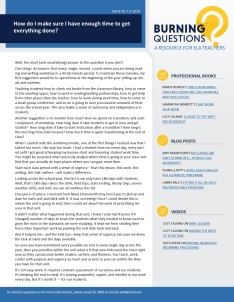 This is a part of the Burning Questions blog series. At the end of each post, you will find resource links and a link to a one-page PDF with the information in the blog — including resources.
This is a part of the Burning Questions blog series. At the end of each post, you will find resource links and a link to a one-page PDF with the information in the blog — including resources.
Well, the short (and somewhat unsatisfying) answer to this question is you don’t.
One thing I do know is that every. single. second. counts when you are doing reading and writing workshop in a 45-60 minute period. To maximize those minutes, my first suggestion would be to spend time at the beginning of the year setting up rituals and routines.
Teaching students how to check out books from the classroom library, how to come to the meeting space, how to work in reading/writing partnerships, how to get help from other places than the teacher, how to work during work time, how to come to a small group conference, and so on is going to save you massive amounts of time across the school year. This also builds a sense of autonomy and independence in students.
Another suggestion is to monitor how much time we spend on transitions and each component. of workshop. How long does it take students to get in class and get started? How long does it take to start instruction after a transition? How long is the teaching time (mini-lesson)? How much time is spent transitioning at the end of class?
When I started with the workshop model, one of the first things I realized was that I talked too much. Like way too much. I had a student time me every day, every period until I got good at keeping my lessons short and honoring student work time. You might be surprised when you truly analyze where time is going in your class and find that you actually do have places where you can gain more time.
Start each class period with a sense of urgency – that this lesson, this work, this writing, this text matters—will make a difference.
Looking across the school year, the fact is we only have 180 days with students. Well, that’s 180 days minus fire drills, field trips, state testing, library days, severe weather drills, and well, we can all continue this list.
One piece of advice I received from Mary Ehrenworth (my hero) was to pick an end date for each unit and stick with it. It was so freeing! Once I could decide this is where the unit is going to end, then I could set about the work of prioritizing lessons in that unit.
It didn’t matter what happened during that unit, I knew I only had X (even if X changed) number of days to teach the students what they needed to know most to grow the most in the standards we were studying. It kept me from stealing time from other important work by pushing the end date back and back.
And it helped me—and the kids too—keep that sense of urgency, because we knew the task at hand and the days available.
So once you have maximized every possible second in every single day across the year, then you prioritize within the unit what is it that your kids need the most right now so they can become better readers, writers, and thinkers. You teach, work, confer with purpose and urgency as much and as best as you can within the time you have for that unit.
It’s not easy work. It requires constant assessment of ourselves and our students. It’s keeping the end in mind. It’s staying purposeful, urgent, and mindful in our work every day. But it’s worth it — for our students.
Professional Books:
Randy Bomer’s Time for Meaning:Crafting Literate Lives in Middle and High School
Samantha Bennett’s That Workshop Book
Lucy Calkins’ A Guide to the Writing Workshop
Lucy Calkins’ A Guide to the Reading Workshop
Blog Posts:
Amy Rasmussen’s My Classes are Only 45 Minutes — How Do I Do Workshop?
Pernille Ripp’s How I Teach English in a 45 Minute Timeframe
Lanny Ball’s Fitting It All in: Solving Predictable Problems
Beth Moore’s Creative Scheduling in Middle School
PD Videos:
Lucy Calkins on Mini-Lessons
Lucy Calkins on Making the Most of Your Time
Ruth Ayers on Writing Workshop Beginning Procedures


